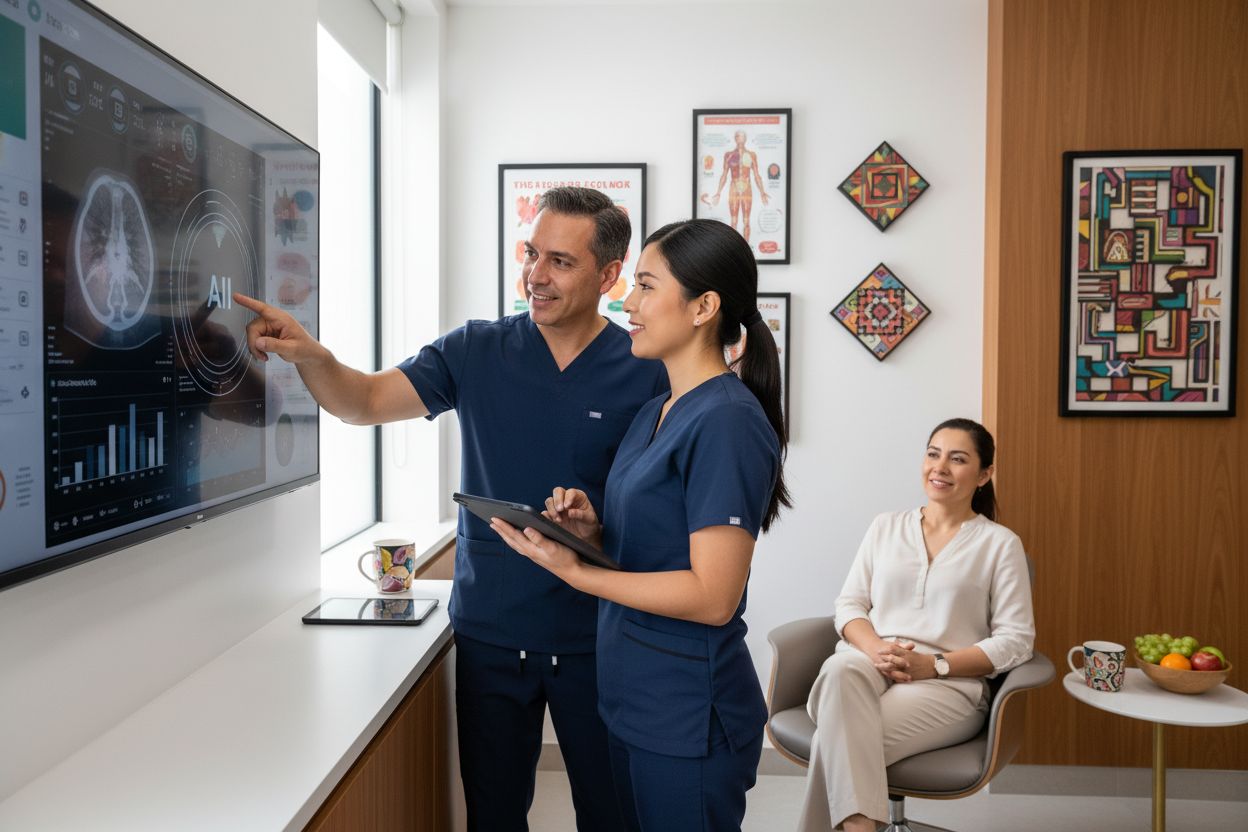Medical documentation seems like an administrative routine, full of forms and data. However, it may come as a surprise that each clinical document tells the complete story of a patient and its proper management has a direct impact on patient safety.. The unexpected is that a simple error or omission in these records can radically change the course of treatment and even have legal consequences. Therefore, learning how to create an effective medical checklist goes far beyond paperwork and becomes the basis for responsible and personalized care.
Table of Contents
- Understands the importance of medical documentation
- Identifies the documents required for patients
- Establishes security and confidentiality standards
- Implement an effective classification system
- Train your team in the use of the checklist
- Review and update the checklist regularly
- Uses digital tools for document management
Quick Summary
| Conclusion | Explanation |
|---|---|
| Medical documentation is crucial | It is essential to ensure quality of care and patient safety. |
| Correctly classifies documents | An effective classification system improves access and reduces errors in medical care. |
| Implement security protocols | Protecting medical information is an ethical and legal duty that all professionals must fulfill. |
| Conducts ongoing training | Continuing education on checklists improves medical practice and patient care. |
| Uses digital tools | Digital technologies optimize document management, facilitating accuracy and accessibility. |
1: Understands the Importance of Medical Documentation
Medical documentation represents much more than just bureaucratic records. It is the core of professional communication and continuity of care in the healthcare system. Each clinical document tells a unique story about the patient's health.The new system has become a vital instrument to guarantee quality medical care.
According to the Pan American Health OrganizationIn addition, proper clinical documentation is fundamental to several critical aspects of medical practice:
- To guarantee the availability of quality data
- Facilitate accurate diagnostics
- Enable a effective communication among health professionals
Medical professionals need to understand that each record not only documents a clinical encounter, but builds a comprehensive patient health history. This documentation serves multiple purposes, from guiding future treatment to providing legal evidence if necessary.
A medical documentation checklist allows this complex process to be systematized, ensuring that no critical detail is overlooked. Learn more about how to optimize your medical notes to improve the quality of your clinical records.
Accuracy and completeness in medical documentation are not optional. They are to protect both the professional and the patientsetting a standard of accountable and transparent medical care.
2: Identifies Documents Needed for Patients
Each medical record requires a systematic collection of key documents to ensure comprehensive and personalized care. Accurate identification of these documents is crucial to maintain a complete and up-to-date record of the patient's health.
According to the Mayo ClinicA personal medical record should contain essential information such as:
- Personal data of the patient: name, age, address
- Medical history full: chronic conditions, allergies
- Medications current and previous
- Emergency contacts
- Consent forms physician
Health care professionals should pay special attention to the comprehensive documentation that reflects every relevant aspect of the patient's health. Discover how to customize your medical documentation templates to optimize this process.
It is essential to create a system that not only collects information, but also protect privacy and confidentiality of the patient. Each document must be treated with the utmost respect and following strict security protocols.
The complete medical documentation acts as a communication tool between professionalsThis allows for a comprehensive understanding of the patient's health status and facilitates more precise and personalized treatments.
3: Establishes Security and Confidentiality Standards
The security and confidentiality of medical information are not only legal requirements, but fundamental ethical commitments in healthcare practice. Each document represents a delicate testimony of a patient's private life.demanding absolute protection.
According to federal telehealth directivesIn order to protect sensitive information, medical professionals must implement rigorous protocols to safeguard sensitive information:
- Access restriction to confidential documents
- Encryption systems for digital records
- Multifactor authentication in management platforms
- Continuous training on data protection
The implementation of a medical documentation checklist requires consideration of multiple layers of security. Explore our secure documentation solutions to optimize data protection.
Professionals must understand that confidentiality goes beyond regulatory compliance. It represents a moral commitment to the dignity and privacy of each patient. Each record must be treated with the same level of respect and care that would be afforded in a personal conversation.
It is essential to develop an organizational culture where the data protection is a fundamental principlenot a mere administrative obligation. Health teams need to understand that each document represents more than information: it represents a human life with its vulnerabilities and innermost secrets.
4: Implement an Effective Classification System
An effective medical classification system transforms document chaos into an organized and accessible structure. Classification is not just an administrative taskbut a critical strategy that directly impacts the quality of patient care.
According to medical documentation researcha robust classification system must ensure:
- Rapid recovery of medical information
- Error reduction in records
- Traceability complete documents
- Standardization of document processes
Implementation requires more than simply labeling documents. It means creating an information ecosystem where each record has a purpose and a strategic location.. Discover how to optimize your documentation templates to improve your classification system.
Each document must be classified considering multiple dimensions: type of information, level of confidentiality, medical specialty, date of creation and clinical relevance. This multidimensional approach ensures that no important detail goes unnoticed.
Health professionals should view the classification as a dynamic and evolutionary toolnot as a static system. The ability to constantly adapt and refine the classification criteria makes the difference between a functional medical record and a truly strategic one.
5: Train Your Team in the Use of the Checklist
Effective training is not just about transferring information, it is about transforming the culture of medical documentation within your team. Implementing a checklist requires a collective commitment and a deep understanding of its strategic importance.
According to patient safety researcha comprehensive training program should include:
- Practical sessions checklist management
- Simulations of real clinical scenarios
- Continuous feedback and improvement
- Periodic evaluation of the implementation
The objective is to create an environment where the checklist is not perceived as a bureaucratic burden, but rather as a a fundamental tool for guaranteeing the quality of care. Deepens diagnostic and documentation techniques to complement your training.
Each team member must understand that their individual participation directly impacts the safety and efficiency of the process. Training is not a single event, but a dynamic process. that evolves with changing equipment needs and technological advances.
It is crucial to develop a continuous improvement mentality, where each professional feels empowered to suggest improvements and adaptations to the checklist, turning medical documentation into a collaborative and constantly optimizing process.
6: Review and Update the Checklist Regularly
The periodic review of the medical documentation checklist is not an option, it is a strategic necessity for maintaining quality and relevance of clinical records. Static systems quickly become obsolete in a constantly evolving medical environment.
According to nursing quality management researchan effective update should consider:
- Changes in clinical protocols
- Team feedback
- New health regulations
- Technological advances in documentation
The revision does not only involve modifying forms, but also comprehensively rethinking how we document medical information. Explore our customized note templates to quickly adapt to these changes.
It is essential to establish systematic review cycleswhere each update is the result of a detailed analysis. It is not a matter of changing for the sake of changing, but of continuously optimizing the processes in order to improve accuracy, efficiency and patient safety.
Healthcare professionals should adopt a continuous improvement mentality, where the checklist is a living document that reflects current best practices, lessons learned and the constant evolution of medical practice.
7: Uses Digital Tools for Document Management
Digital tools have radically transformed medical document management, converting what was once a tedious process into a efficient and accurate strategy. Digitization is not a luxury, it is a fundamental necessity in modern medical practice.
According to Internet Medical Researchdigital tools offer critical benefits:
- Instant accessibility of records
- Error reduction of documentation
- Standardization of processes
- Integration of information between specialists
Digital transformation goes beyond digitizing documents. It means creating an ecosystem where information flows in a secure, immediate and organized manner. Discover how to optimize your medical documentation with cutting-edge tools.
Health professionals should view these tools as strategic alliesnot as simple paper replacements. The real revolution lies in how these technologies enable smarter, predictive, patient-centered management.
The key is to select tools that not only comply with safety regulations, but also adapt to the specific dynamics of each medical team, enhancing efficiency without compromising the quality of care.
Below is a summary table that organizes the key points of the article, providing a comprehensive overview of the steps and benefits of creating an effective medical documentation checklist.
| Step / Key Element | Main description | Benefit highlight |
|---|---|---|
| Understands the importance of medical documentation | Each clinical record builds a complete and secure patient history, vital for diagnosis and continuity of care. | Ensures quality and safety in patient care |
| Identifies the documents required for patients | Includes personal data, medical history, medications, contacts, and consent forms in the file. | Facilitates comprehensive and personalized attention |
| Establishes security and confidentiality standards | Implement restricted access, encryption, authentication and data protection training. | Ensures ethical and legal compliance, protects patient privacy |
| Implement an effective classification system | Organizes documents according to type, confidentiality, specialty and relevance, allowing for easy retrieval and control | Reduces errors and improves clinical access |
| Train your team in the use of the checklist | Continuous training, simulations and feedback to develop responsible documentation culture | Improves the quality and consistency of records |
| Review and update the checklist regularly | Evaluates and adapts the checklist to clinical changes, regulations and technological advances | Maintains relevance and accuracy in document management |
| Uses digital tools for document management | Digitization, integration and secure accessibility of medical records. | Optimizes efficiency and reduces documentation errors |
Transform your Medical Documentation Checklist with Artificial Intelligence
Have you ever felt overwhelmed by the risk of missing key information or the difficulty of keeping your medical records accurate and organized? Manual processes often consume valuable time and can lead to errors that affect quality of care and patient safety. An efficient checklist, as you explored in this article, is just the beginning. With the tools designed by Itaca.ai you can take the next step towards a much more agile, secure and accurate clinical document management. Discover ideas and recommendations in our Guides Archives - Itaca to take your processes to the next level.

It has never been more urgent to optimize workflow, increase documentation accuracy and protect your patients' sensitive data. Choose Itaca.ai to automate the generation of SOAP notes, access intelligent diagnostic support and always maintain the confidentiality of information. Visit our New Features Archives - Itaca to learn about the innovative capabilities that are transforming medical practice today. Take the leap and make sure your checklist evolves along with the best technologies in healthcare.
FAQ
Why is medical documentation important in a checklist?
Medical documentation is critical to ensure continuity of care, diagnostic accuracy and effective communication between healthcare professionals. Each record contributes to a comprehensive history of the patient's health.
What documents should be included in a medical record?
A complete medical record should contain the patient's personal data, medical history, current and past medications, emergency contacts and consent forms. This ensures comprehensive and personalized care.
How can I ensure the confidentiality of medical documentation?
To ensure confidentiality, security protocols such as access restriction, data encryption, multifactor authentication, and ongoing staff training on data protection must be implemented.
How often should I review and update the medical documentation checklist?
It is advisable to review and update the checklist on a regular basis to ensure its relevance and effectiveness. This includes considering changes in clinical protocols, team feedback and new healthcare regulations.
Recommendation
- Announcing 9 New Note Types: Tailored Documentation for Every Patient Visit - Itaca
- ✍️ Note templates: customize the generated notes according to your preferred format - Itaca
- SOAP Notes: A Complete Guide for Health Professionals - Itaca
- Understanding Differential Diagnosis: A Complete Guide for Health Professionals - Itaca





Leave a Reply